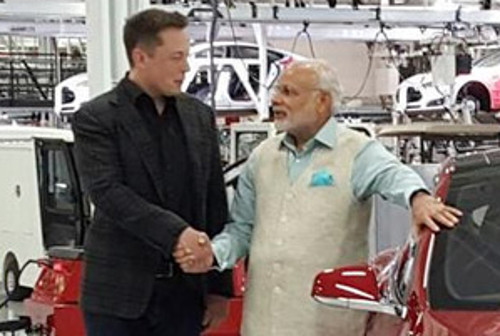On Saturday, September 26th, the Prime Minister of India Narendra Modi visited Tesla’s Fremont, California factory.
Apparently he liked what he saw.
Of course, Elon Musk was there to personally welcome Modi to the factory, with the Indian national flag hanging next to the American flag to honor the occasion.
Tesla’s CTO, J.B. Straubel, then showed Modi the operations of the factory, including the high-tech robotic assembly lines and the inside of Tesla’s lithium-ion battery pack.
In between technological marvels, Musk and Modi discussed business. According to Fortune, Musk informed the Ministry of External Affairs in India that the future of the country’s electricity generation was a major topic.
Now, I’ve talked before about the potential of solar power in India. Many rural areas in the country are cut off from the major energy grids, and small solar set-ups have appeared to fill in the gaps where the grid can’t reach.

But Musk wants to take things a step farther: he suggested that India avoid the idea of national grid power altogether and skip right to distributed, or individualized solar and battery packs.
There is a large potential market for Tesla in India, especially if paired with a solar company like SolarCity. Combined installations of solar panels and lithium batteries could greatly reduce India’s energy poverty.
However, there is one market Tesla will not be able to get a hold on just yet: India’s automobile market.
Remember that even though India is open to the idea of solar power for homes and businesses, Tesla’s Model S and Model X will still only be a luxury for India’s richest for some time to come — at least until the more affordable Model 3 comes into play.
Yet Tesla isn’t the only company that got a shot at India’s business. Prime Minister Modi also met with Mark Zuckerberg of Facebook, Tim Cook of Apple, and Sundar Pichai of Google.
India’s cities harbor a growing number of technology industries and intellectuals who would benefit from increased services from these companies. The country is expected to have 236 million Internet users by next year; new business will have to move fast to keep up!
To continue reading…
Click here to read the Fortune article.
Until next time,

Keith Kohl
A true insider in the technology and energy markets, Keith’s research has helped everyday investors capitalize from the rapid adoption of new technology trends and energy transitions. Keith connects with hundreds of thousands of readers as the Managing Editor of Energy & Capital, as well as the investment director of Angel Publishing’s Energy Investor and Technology and Opportunity.
For nearly two decades, Keith has been providing in-depth coverage of the hottest investment trends before they go mainstream — from the shale oil and gas boom in the United States to the red-hot EV revolution currently underway. Keith and his readers have banked hundreds of winning trades on the 5G rollout and on key advancements in robotics and AI technology.
Keith’s keen trading acumen and investment research also extend all the way into the complex biotech sector, where he and his readers take advantage of the newest and most groundbreaking medical therapies being developed by nearly 1,000 biotech companies. His network includes hundreds of experts, from M.D.s and Ph.D.s to lab scientists grinding out the latest medical technology and treatments. You can join his vast investment community and target the most profitable biotech stocks in Keith’s Topline Trader advisory newsletter.





